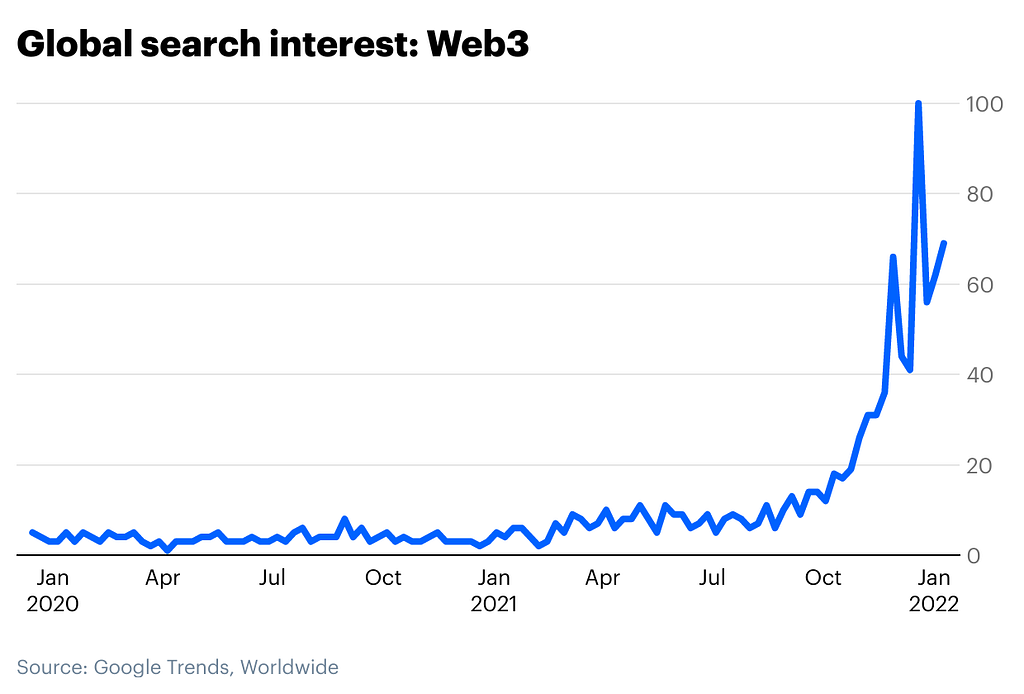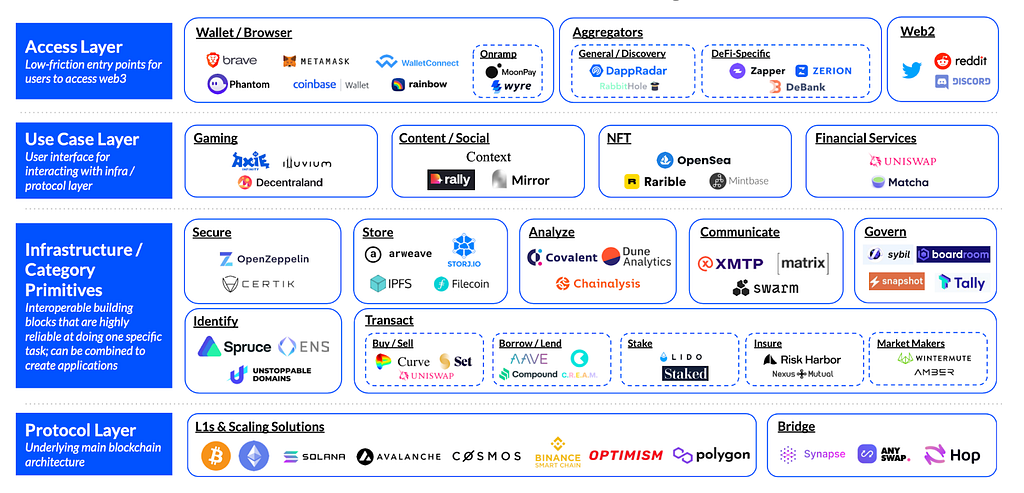Coinbase: A Simple Guide to the Web3 Stack
Source: Coinbase Blog
Original Title: 《A simple guide to the Web3 stack》
Compiled by: Hu Tao
The industry has proposed many definitions of web3, but at Coinbase, we generally consider Web3 to be a trustless, permissionless, and decentralized internet that utilizes blockchain technology.
The defining characteristic of Web3 is ownership. The first iteration of the commercial internet (Web1) was read-only for most users, while Web2 allowed users to read and write on centralized platforms (Twitter, Facebook, YouTube, etc.), and Web3 empowers users with full ownership of their content, data, and assets through blockchain. It enables users to autonomously read and write .
In the case of third parties like Facebook owning your identity and data in Web2, your identity in Web3 can move seamlessly between platforms, and your data will not be captured and monetized by service providers. While Web2 applications are centrally controlled, tokens in Web3 grant users rights to help manage the services they use, representing a form of ownership of the platform itself.
With this framework in mind, what does the Web3 stack look like?
Web 3 Stack
The Web3 stack is still nascent and fragmented, but it is beginning to take shape with significant innovations over the years. The following content is neither mutually exclusive nor fully exhaustive. Rather, it is a framework for thinking about this situation that is continuously evolving.
Let’s start from the bottom up.
Protocol Layer
At the bottom of the stack, we have the protocol layer. This consists of the underlying blockchain architecture upon which everything else is built.
Bitcoin is the pioneer, and while it does not play a significant role in today's Web3, it pioneered the ability to own scarce digital assets through the use of public-private key cryptography. Following Bitcoin, a series of Layer 1 smart contract platforms emerged, such as Ethereum, Solana, Avalanche, Cosmos, etc., which form the basis of many Web3 applications currently in production.
Both Bitcoin and Ethereum have additional protocols built on top of them. Bitcoin has networks like the Lightning Network (for fast and cheap payments) and Stacks (for smart contracts). To alleviate its capacity limitations, multiple Layer 2 scaling protocols have been built on Ethereum.
With the rise of many Layer 1 and Layer 2 networks, there is a need to bridge them. Enter cross-chain bridges that act as highways, allowing users to transfer value from one chain to another (useful cross-chain dashboards can be found here and here).
Infrastructure Layer
The infrastructure layer sits above the protocol layer and consists of interoperable building blocks that are highly reliable when performing specific tasks.
This is a dense and diverse layer, with projects building everything from smart contract auditing software, data storage, communication protocols, data analytics platforms, DAO governance tools, identity solutions, financial primitives, and more.
For example, Uniswap facilitates the exchange of one asset for another. Arweave enables data to be stored in a decentralized manner. ENS domains can serve as user identities in the Web3 world. Users cannot do much with each individual application. However, when combined, these category primitives act like Lego blocks that Web3 developers can use to build applications.
Use Case Layer
Above the protocol layer and infrastructure layer is the use case layer, where all of these come together.
Take blockchain-based games like Axie Infinity as an example, which uses Ethereum tokens and NFTs and can bridge to a low-cost/high-throughput sidechain called Ronin. Players often use Uniswap to swap ETH for the tokens needed to play the game. Similarly, the decentralized blogging platform Mirror uses the storage protocol Arweave to store data. At the same time, it leverages Ethereum to reward publishers with cryptocurrency, often by directing tokens to their ENS addresses.
You will notice that Uniswap appears in both our infrastructure and use case sections. This is because, while the core of Uniswap is just a series of smart contracts, it also provides a front end that users can interact with directly. In other words, it serves as both a standalone user-facing application and the infrastructure for other Web3 applications (like Axie Infinity).
Access Layer
At the top of the stack is the access layer—applications that serve as entry points for various Web3 activities.
Want to play Axie Infinity or pay for your content on Mirror? You first need a wallet, which is the primary entry point for most Web3 applications. Users need fiat on-ramps like Moonpay or Wyre, or cryptocurrency exchanges like Coinbase to get started.
With some cryptocurrency in their wallets, users can head to aggregators like DappRadar to browse and connect to various Web3 applications in one place. Other projects like Rabbithole help users discover and learn how to use various Web3 applications. There are also aggregators like Zapper, Zerion, and Debank that help users track all their activities and assets across various applications.
Finally, we are approaching a future where Web2 platforms that have already gathered the crypto community, such as Reddit and Twitter, will become entry points for Web3. Reddit's long-awaited crypto plan will allow certain communities to be tokenized, rewarding users who actively participate with tokens and possibly NFTs. Twitter has already integrated with the Bitcoin Lightning Network, allowing users to tip others in BTC.
An Evolving Stack
The protocols, infrastructure, user applications, and access points mentioned above constitute the nascent but evolving world of Web3: an internet owned by users. Beyond ownership, the power of Web3 lies in its modularity and interoperability. Essentially, this means that the above stack can be combined in countless ways to create new and interesting use cases—we expect this feature to lead to an explosion of new, world-changing applications during a Cambrian explosion.
While the framework and layers we emphasize may remain constant, we anticipate that the projects and opportunities within them will undergo significant changes in the coming years.
















